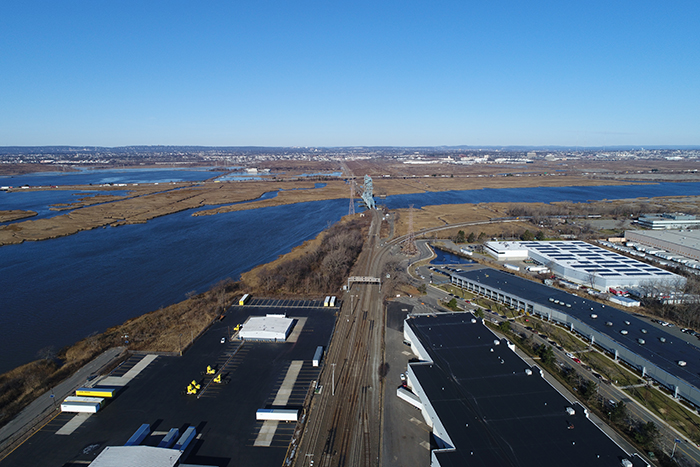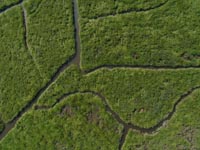
MEADOWLANDS RESEARCH & RESTORATION INSTITUTE (MRRI)
One of MRRI’s main objectives is assisting in the recovery of the region’s sensitive environment and preparing for future challenges such as sea level rise.
Their work in improving water quality in the Hackensack River has contributed to the return of a great number of wildlife to the Meadowlands District. More than 285 species of birds alone, including many on the State threatened and endangered lists, have been identified in the Meadowlands District over the past few decades.
The Institute constantly monitors water and sediment quality and elevation in the Hackensack River. The information gathered helps researchers to understand the conditions of the system and develop policies and programs that improve the River’s health. MRRI collects water samples at 14 sites on the lower Hackensack River and its tributaries every quarter. This assessment provides a general outlook of overall water quality in the Meadowlands estuary.
GRANTS AND STUDIES
In September, the U.S. Environmental Protection Agency recognized MRRI’s work in protecting and enhancing the Meadowlands natural resources by awarding the NJSEA three grants totaling $547,000 to cover three projects.
The research includes studying Meadowlands marshes that have the greatest chance of resiliency under future sea level rise, examining the Sawmill Creek Wildlife Management Area’s potential to provide improved habitat and sequester carbon under changing climate conditions, and management and publication of drone imagery for long-term monitoring of the Meadowlands District, which includes acquiring important data on terrain elevation and land cover.
Through a partnership with the New Jersey Institute of Technology, MRRI received a $150,000 grant from the State Department of Environmental Protection to help mitigate hazardous algae blooms in New Jersey’s fresh waters. MRRI will be operating a specially designed, 22-foot boat and equipment to mechanically remove algae starting in the spring of 2022.
A study completed in 2021 involved exploring the relationship between water table levels and weather events with contaminated trace metal movement and redistribution. By sampling five wells in a marsh, researchers looked to better understand the relationship between climate change and sea level rise, and the redistribution of legacy trace metals buried and immobilized in sediments MRRI also installed new sediment elevation tables in two marshes, making a total of eight locations in the Meadowlands that are actively being monitored for sea level rise and sediment accretion.
EDUCATION PARTNERSHIPS
The Institute mentored 15 students, including high school students from the Bergen County Academies, and undergraduates, graduates and Ph.D. students from various colleges. MRRI also works with and shares data and analysis from its research with Rutgers University, Princeton University, the New Jersey Institute of Technology, Cornell University, and the City University of New York, greatly assisting professors and students in their research.
DRONE TECHNOLOGY


MRRI’s drone technology continued to support the NJSEA’s storm water management and flood protection efforts by monitoring berms for breaches and supporting tide gate inspections. Data gathered from drone flights and Geographic Information Systems (GIS) digital maps are also used to assist several NJSEA departments in various projects.
MRRI is also involved in drone training programs to create the next generation of drone pilots. The Institute provided training to the American Association of Professional Geologists, Mid-Atlantic Region.
TIDE GATE MONITORING AND FLOOD ALERTS
MRRI has installed real time monitoring instruments on 12 key tide gates throughout the Meadowlands District. Water levels are reported via satellite phone to a central command post at the Institute’s headquarters at DeKorte Park in Lyndhurst. Staff continuously monitor tide gate functionality and promptly coordinate repairs when necessary.
MRRI also oversees a water level alert system and provides flood prediction maps to first responders and the public, which is especially critical as the Meadowlands District lies within a low-lying area. The email and text-based alerts for District towns are sent when water levels reach 4.75 feet above sea level and continue to be relayed as the levels rise.
The interactive, web-based flood prediction maps include the parts of District municipalities that may flood from sea surge levels of 4 to 8 feet. The maps may be seen on the MRRI section of the NJSEA website, njsea.com.
MOTUS TOWER
MRRI staff in 2021 constructed a Motus Tower on NJSEA property, linking up with the Motus Tower network which stretches from Canada down to South America. These towers allow researchers to track the movements of flying animals too small to support traditional satellite or GPS methods. Using the towers, researchers can track migrant species, including songbirds, raptors, seabirds, bats and monarch butterflies, which have been tagged by participant researchers. Motus’ goal is to combine individual research projects into a massive, collaborative, coordinated, hemispheric network.
Working with other entities, MRRI staff will be installing geotags on songbirds within the District, and the signals from the tags will be picked up by the Motus Tower network as the birds migrate. Staff will also be downloading the collected data from the Motus Tower, which will then be shared on the Motus website and will be available to the general public and other researchers.
The NJSEA Motus Tower was made possible through the agency’s partnership with the Bergen County Audubon Society, Kean University, PSE&G and the Willistown Conservation Trust.
MEADOWLANDS BREEDING BIRD ATLAS
MRRI undertook the development of a first-of-its-kind Meadowlands Breeding Bird Atlas. The Meadowlands has long been recognized as a critical resource for birds and other wildlife, and has been the subject of many research projects on the occurrence, relative abundance and diversity of birds within the District.
However, the breeding habits of birds within the Meadowlands have not been fully studied. To fill this gap, MRRI staff, with assistance from volunteers from the Bergen County Audubon Society and Hackensack Riverkeeper, undertook a study of breeding birds in the Meadowlands District.
The Meadowlands Breeding Bird Atlas (BBA) is a survey of birds that use the Meadowlands for breeding purposes. The results of the Breeding Bird Atlas will inform the NJSEA as to which species breed in the District and what sites and habitats are used for breeding. In addition, the development of the Atlas will help fill an existing research gap and aid in identifying species and habitats that may be important to future conservation and restoration actions. The study will also highlight the success of breeding birds in the Meadowlands, and will be used to develop policies and programs to conserve and restore bird habitat loss within the District.
WILDLIFE HABITATS AND PUBLIC EDUCATION
MRRI staff continued its management of NJSEA open spaces and wildlife habitats by using innovative techniques to better manage invasive species; constructing and placing bird nesting platforms and boxes; and working with other regional and State agencies and universities to develop more efficient monitoring methods.
To bring information to the public in meaningful ways, MRRI staff worked with universities and non-profit organizations to explore pioneering and new educational platforms to engage and inform the public. MRRI staff also participated in the NJSEA’s successful annual public celebrations of the Meadowlands environment, which included Native Plant Day, Butterfly Day and the Meadowlands Birding Festival. During these events, staff shared their knowledge of the Meadowlands and its natural resources with the public and led tours through different Meadowlands habitats. MRRI staff attended numerous conferences, both live (in the field) and virtually, giving presentations at this year’s annual meetings for the Society for Ecological Restoration, Society of Wetland Scientists and Restore America’s Estuaries Living Shorelines Conference. MRRI also attended conferences and workshops from the Association of State Wetland Managers, Mid-Atlantic Wetland Working Group, The Waterfront Alliance and New Jersey Coastal Resilience Collaborative.